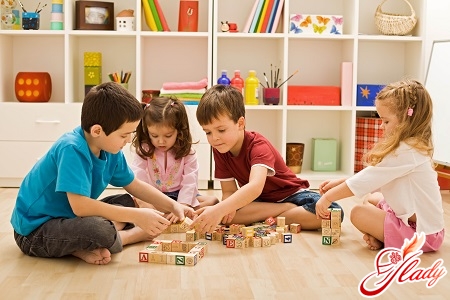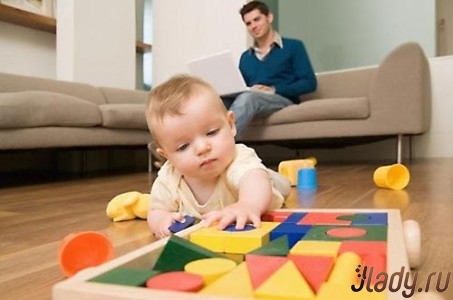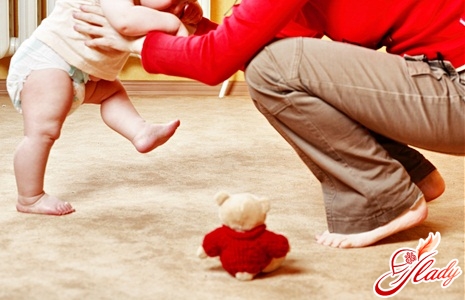 Which baby walkers to choose - from whichage, how, why? These questions are regularly discussed and argued over. Parents of all children, of course, have heard and know about walkers and jumpers. However, not all of them buy them for their children. As a rule, all parents are divided into two main groups - supporters of the use of walkers and jumpers and their ardent opponents. Moreover, the arguments "baby walkers - pros and cons" sound equally convincing. Baby walkers reviews have both positive and negative. In this article, we will try to tell in the most detail about the benefits and harm of both walkers and jumpers. However, please note that this is only general information. If you decide to buy a walker, first consult with your doctor - pediatrician.
Which baby walkers to choose - from whichage, how, why? These questions are regularly discussed and argued over. Parents of all children, of course, have heard and know about walkers and jumpers. However, not all of them buy them for their children. As a rule, all parents are divided into two main groups - supporters of the use of walkers and jumpers and their ardent opponents. Moreover, the arguments "baby walkers - pros and cons" sound equally convincing. Baby walkers reviews have both positive and negative. In this article, we will try to tell in the most detail about the benefits and harm of both walkers and jumpers. However, please note that this is only general information. If you decide to buy a walker, first consult with your doctor - pediatrician.
Benefits of Walkers
Any young mother knows how difficult it can be sometimesthere are enough free hands, on which the baby constantly sits. After all, in addition to everything else, most often on the shoulders of the woman lies cooking, cleaning, washing and caring for the rest of the family. And this is very difficult to do if the woman is occupied exclusively with the baby all the time. Using walkers makes life much easier for a young mother and frees up time. As you know, from about 6 - 8 months, a real explorer wakes up in the baby. The child no longer agrees to spend hours in the playpen, he wants to explore the world around him and participate in the life of adults. In walkers, the reach zone for the baby is significantly expanded and the baby does not feel cut off from the outside world. In addition, a baby in a walker, thanks to a new vertical position for him, develops a little faster than his peers, both in emotional and intellectual, and in social development. Children in walkers are much more sociable, ready for emotional contact, loyal to strangers.
Benefits of javelins
Jumpers are a little less widespread,than walkers. Jumpers are a kind of device on springs, in which the child is placed. Pushing off the floor, the child seems to fly up. As a rule, children love jumpers and willingly spend a long time in them. Jumpers remarkably strengthen the vestibular apparatus and stimulate the development of all muscle groups of the baby. However, the question "children's jumpers - from what age" is also relevant, as in the situation with walkers. Jumpers can be used simply as entertainment for the baby. While the baby is in the jumper, the mother's hands are free and she can do housework or spend some time for herself. After all, free time is exactly what all women always lack, and not just young mothers. However, jumpers are often used for therapeutic purposes. Pediatricians recommend using jumpers as a therapeutic and preventive exercise machine for those children who suffer from the following diseases:
- Reduced muscle tone and weakness of the shoulder.
- Reduced tone and weakness of the muscles of the shoulder girdle and hands.
- Rehabilitation course after injuries.
However, if jumpers are usedas a rehabilitation exercise machine, the time of their use, as well as the frequency, should be determined only by the baby's attending physician, under strict parental supervision. In such a case, excessive time spent in the jumpers can negatively affect his condition and worsen the course of the disease.
Cons of walker
However, if everything were so rosy, there would be no debate about whether to use a walker or not. There are also a number of disadvantages that walkers have:
- Slowing down the development of motor skills
It has been reliably established that the use ofwalkers significantly slow down the development of motor skills in the baby. This happens because there is not enough psychological stimulation of the child's need for movement. Why should a baby strive to learn to walk independently, put any effort into it, if he can easily move in a walker?
- Deformation of the skeleton
In the event that parents too oftenIf you abuse walkers, leaving your baby in them for a long time, there is a risk of leg deformation and spinal curvature. Therefore, if you use walkers, do not leave your baby in them for more than 30 minutes, so as not to provoke the development of health problems.
- Development of the cerebellum
Pediatricians believe that the usewalkers do not have the best effect on the normal physiological development of the cerebellum and its function. This happens because a child who is in a walker for a long time gets used to the fact that he does not need to maintain balance while walking, because the walker evenly supports him from all sides. As a result, the development of the cerebellum deviates from the normal, and when trying to walk independently, the baby constantly falls. In addition, as everyone knows, an important skill for a baby is the ability to fall correctly. This skill will save the baby's nose and head from unnecessary injuries more than once. A baby in a walker is completely deprived of this opportunity to learn to fall. It goes without saying that no parent wants their baby to fall and get bruises and bumps. However, remember - without ever falling, the child will never learn to do it correctly. But you will not be able to keep him in a walker all his life. While the child is small, the risk of serious injury is very small - after all, the fall occurs from a small height of his own height. And during the fall, he learns to group muscles and protect vital organs. This skill will protect the child more than once in adulthood.
- Lack of sense of danger and caution
Every living creature has what is calledsense of danger. The sense of danger is an invariable companion of the instinct of self-preservation inherent in living organisms. A baby who walks in a walker has bumpers on all sides. Whether the baby bumps into a stool or a wall, he will not experience any particular discomfort. The child does not learn to feel the edges, avoid collisions and in the future he can get seriously injured.
- Cognition of the world around us
As you know, a baby is very active in learningthe world around us. And learning occurs mainly tactilely – through hands and mouth. A baby in a walker is deprived of this opportunity, because the walker limits his ability to pick up anything. On the one hand, this is good – the chance that the child will reach dangerous objects is zero. But on the other hand, even reaching his toy becomes an impossible task for the baby.
- Increased traumatic danger
With all its positive qualities, walkersare quite dangerous. Walkers very often tend to turn over, hit walls and door frames. The speed of a baby in a walker, it must be said, is quite decent - about 10 km / h. You understand that when moving at such a speed, the joints of carpet coverings, for example, carpet and laminate, can cause the walker to tip over. And such a fall is much more dangerous than if the child fell on his own, without a walker.
- Problems with the feet
In a walker, the baby almost always pushes off the floor with the tips of the toes. And for the correct development of the foot, the child should gradually move to standing on the entire plane of the sole.
- Tension of the dorsal muscles
Due to the fact that the baby is in the room for a long timein a walker, he often experiences excessive strain on his back muscles. Because of this, the baby not only experiences discomfort, but also risks getting a curvature of the spine. This happens because he is forced to be in a vertical position and is unable to change it - after all, the baby cannot yet independently let adults know that he is tired.
The jump jumps
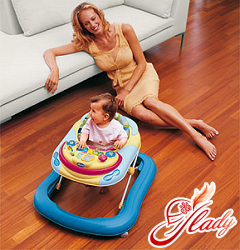 Jumpers, too, with all their positivequalities have a number of disadvantages. Jumpers for children have slightly different pros and cons than walkers. Be sure to take this into account when deciding to buy jumpers:
Jumpers, too, with all their positivequalities have a number of disadvantages. Jumpers for children have slightly different pros and cons than walkers. Be sure to take this into account when deciding to buy jumpers:
- Muscle tone
If a child spends more than an hour a day in a jumper, there is a very high risk of developing muscle hypertonicity. Muscle hypertonicity, in turn, leads to complications for the child's body.
- Pulling the perineum
The design of the jumpers is such that they last for a long timeBeing in them leads to compression of the child's perineum. This is especially pronounced in boys. This can also lead to complications, so do not leave the child in jumpers for a long time under any circumstances.
- Coordination of movement
While in the jumper, the child pushes off fromthe floor surface with both feet at once. As a result, this is fixed in his subconscious and, when trying to walk, the child will try to push off with both feet. As a consequence of this, the child will constantly fall in the process, and begins to walk a little later than his peers.
Psychological influence of walkers
Most often you can find information about the physicalinfluence of walkers. But in fact, the psychological side of this issue is no less important, and often even more so. Of course, the psychological side of using walkers and jumpers does not make itself known immediately, so after some time, when a problem arises, parents usually do not associate it with the use of walkers and jumpers.
- Cycle period
As you know, crawling is one ofnecessary conditions for the correct and harmonious development of the child. Thanks to the process of crawling, brain connections between the right and left hemispheres develop. This often leads to the emergence of a fairly large number of problems in the future. For example, one of the possible complications may be poor performance at school. Such children often have serious problems with learning to read - the child reads by syllables, can change their places or try to guess what exactly is written. Agree - few parents will guess to connect these failures with the child's crawling in infancy.
- Restriction of free movement
In order to physically and psychologicallythe child's development proceeds correctly, the child must move freely in space. For example, a child sees an object that interests him, he will definitely try to reach it - crawl, stretch out his hand or take a step towards the target. A child in a walker is often deprived of such an opportunity, since the walker greatly limits the baby's freedom of movement. Some parents may object - a child in a walker has a large degree of freedom of movement - where the child wants, there he goes. However, this is not true - after all, a child in a walker cannot sit down, bend over, sit down or lie down. The child can simply hang, barely touching the floor with his fingertips. Of course, there can be no talk of any freedom of movement in such a situation. And such a restriction in movement in the first year of life especially strongly affects the ability to move.
- Awareness of your body
During the first year of life, a child learnscontrol your body, learning its capabilities and limitations. In order for this process to proceed correctly, the child must be able to move as much as possible. If the child is limited in motor activity, as is the case with the use of walkers, the child has a very vague idea of his body for a very long time. Most often, walkers are very popular with children who enthusiastically spend a significant amount of time in them and, as mentioned above, walkers can make life much easier for parents. Walkers are an interesting, exciting toy for any baby, helping the baby to explore the world around them. But remember that in no case should you leave a child in a walker or jumper unattended even for a minute. As we have already said, opinions about the benefits and harms of walkers are opposite. Some people grow up smart and healthy children with walkers, and some do not use them. The most reasonable thing, when making a decision about a purchase, would be to focus on the individual characteristics of each specific baby. If you really want to buy a walker, go ahead. However, keep in mind that parents must follow certain rules to use the walker safely:
- Age limits
Under no circumstances should you put your child in a walker.four to five month old baby. You can use a walker only if the baby crawls confidently and tries to stand on his own feet. Early use of a walker can lead to very serious health problems for the baby.
- Temporary constraint
In order not to overload the musculoskeletal systembaby's system, do not leave the baby in the walker or jumper for more than an hour and a half. Please note that this time should be divided into three or four approaches. The approximate time of continuous stay should not exceed 20-30 minutes. In addition, such a measure will help to minimize the load on the arch of the baby's foot. Increased load on the foot is fraught with such a formidable complication as the occurrence of pathological stiffness of the foot. This will have the most negative effect on further learning to walk.
- Jumpers on the jumpers
As mentioned above, use jumpersis recommended not earlier than the child begins to stand on his own feet. However, there is an exception to these rules. For example, if the jumpers are used as a rehabilitation trainer, they can be used from the age of four months. In this case, the child can be in the jumpers only in special straps that are threaded under the baby's arms. This measure is simply necessary in order to reduce the load on the fragile child's spine. When the baby grows up, these straps can be easily unfastened.
- Adjusting the walker
Correct seat height adjustment is veryis important. Be sure to adjust it so that the child is not forced to dangle in the walker, unable to reach the floor. The child should be able to reach the floor and push off from it without effort.
- Footwear
It is also important to choose the right shoes.It should be light and very comfortable, with a soft sole. If the floors are warm, the best option would be socks with a non-slip sole. Or if you still put shoes on your baby, choose shoes so that the baby places his foot correctly - not with his toes, but with the entire surface of the foot and has the ability to bend his legs for pushing.
- Security
Before you put your child in a walker,Be sure to make your apartment safe. Remove all dangerous objects that your child can reach – vases, scissors, remote controls, mobile phones. Do not put your child in a baby walker until you are sure that the apartment is safe for your child. The most effective way to check this is to get down to the child’s height level. Squat down and look around – are there any dangerous objects within reach. Be sure to make sure that your child cannot reach the stairs.
How to choose the right walker?
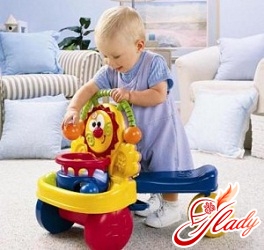 So, you have decided that the walker is stillbe. Before you go shopping, carefully read the recommendations below on how to choose the right walker so that it brings only benefit and pleasure to your baby. Low-quality walkers are not only inconvenient to use, but also pose a threat to the baby's health. Recently, online stores have become very popular. Of course, such purchases are very convenient, especially for young parents - shopping with a child is not the most exciting activity. However, walkers, like a baby stroller, are an exception. It is advisable to see them with your own eyes, independently check the strength of all fasteners. When buying walkers, parents should pay attention to the following important aspects that suggest how to choose a baby walker.
So, you have decided that the walker is stillbe. Before you go shopping, carefully read the recommendations below on how to choose the right walker so that it brings only benefit and pleasure to your baby. Low-quality walkers are not only inconvenient to use, but also pose a threat to the baby's health. Recently, online stores have become very popular. Of course, such purchases are very convenient, especially for young parents - shopping with a child is not the most exciting activity. However, walkers, like a baby stroller, are an exception. It is advisable to see them with your own eyes, independently check the strength of all fasteners. When buying walkers, parents should pay attention to the following important aspects that suggest how to choose a baby walker.
- The base of the walker
It is very important to choose a walker with good stability.and a wide base. This is simply necessary for the baby's safety - if the base is wide, the baby, even if he tries to bend over, will not turn over with the walker. Ideally, on more expensive models, such as chicco baby walkers, the edges of the sides are rubberized. This is done so that the walker, in the event of a collision with an obstacle, absorbs shock and softens the impact.
- Wheelsets
The wheels are also very important forsafety and convenience of the walker. The wheels should be as large in diameter as possible. This directly affects the stability and maneuverability of the walker. It is advisable to give preference to rubber wheels, as they, unlike plastic ones, provide a softer ride for the walker. In addition, the wheels should easily turn in all directions.
- Sitting of the walker
The position of the walker is no less important.In order for the baby to be comfortable, the seat must meet several parameters. Firstly, the seat must be deep enough - this is necessary so that the baby does not fall out of it. In addition, it is very important to pay attention to the material from which the seat is sewn. When the baby is in the walker, the entire load is distributed between the baby's legs. That is why the fabric must be soft enough, but at the same time dense so that it does not sag.
- Back
It is highly desirable that the seat in the walker beequipped with a backrest. The backrest should be high and hard – only in this case it will properly support the baby’s back, preventing him from tipping over backwards. Please note that in good models of walkers, the seat is equipped with an additional internal protective bumper, which protects the baby from injury in the event of a fall or collision. In addition, pay attention that the backrest of the seat is removable and easy to wash. Children tend to very quickly stain the seat with food, juices or mixtures. Although, frankly speaking, pediatricians strongly advise against feeding a child in a walker. The child should eat in his designated place, and not during play. But walkers are nothing more than an exciting game for your baby.
- Height of walker
It has already been said above that it is unacceptable thatthe baby strongly bent his legs at the knees or, on the contrary, barely touched the floor with his fingertips. This position of the child negatively affects the correct formation of the child's musculoskeletal system. Therefore, be sure to ensure that the model of the walker you choose is adjustable in height. Most often, such adjustment is carried out by lowering or raising the seat.
- Compactness
In the event that the residential premises haverelatively small size, it may be worth giving preference to those models that can be folded. When folded, they take up much less space, they are easy to move from place to place and store. The only thing you should pay attention to is the strength of the walker on the nodes.
- Safety of walker
Be sure to pay attention to the weight thatthe walker is designed for. If your child is quite thin, choose a walker designed for children weighing 10-15 kilograms. But if the baby is large, then you should give preference to models designed for a weight of 15-20 kilograms. This information is in the instructions for any model of walker.
- Additional Features
There are a huge number of differentmodels of walkers equipped with various additional options. Some models have a removable tabletop that can be removed and washed, a game panel or a music panel. Here, when choosing, you should focus only on personal preferences. However, remember that when buying a walker with a music panel, you risk losing your peace for a long time.
How to choose a jumper?
Sometimes it can be difficult to buy children's jumpers.If the principle of choosing a walker is more or less clear, then when buying a jumper, parents have a huge number of questions. To choose the right jumper, pay attention to the following:
- Mountings
All jumpers have fastenings.The fasteners can be in the form of brackets, hooks or rings. These fasteners are screwed into the doorway. All types of fasteners are mobile - they can be moved from place to place, depending on where it is more convenient for the mother - for example, in the room or in the kitchen. When choosing a jumper, be sure to ensure that the fasteners are made of metal, not plastic. Plastic fasteners can burst and the baby will fall.
- Belts
How jumpy the "jumpers" are depends only onfrom the type of belts that are attached to the seat. They are attached in two ways - either with an elastic band or with a spring. Fastening with a spring is considered the most optimal and safe. Pay attention to this when buying jumpers. In addition, it is very important that the belts have the ability to be adjusted in length.
- Seat
The requirements for sitting jumpers are even greaterstrict requirements than for the seat of the walker. It should be very deep so that the baby could not fall out of the jumper under any circumstances. The ideal option is a seat in the form of panties that fit tightly to the baby's body and securely fix it, preventing it from falling out. In good models of jumpers, the seat is additionally equipped with a rigid orthopedic back that supports the baby's spine and evenly distributes the load. Baby jumpers with a back have the most positive reviews. Also, be sure to pay attention to the fact that the seat is wide enough - otherwise, the narrow strip of fabric between the baby's legs will squeeze the perineum and cause significant discomfort to the child. And give preference to a material that can be easily washed. After all, baby jumpers also get dirty quickly, especially if parents do not put diapers on the baby at home.
Go-carts
Another type of walker that is very popular with everyone.children - walkers - ride-on. This type of walker is designed for children who have already learned to walk on their own. Such walkers are a toy on wheels, which the baby pushes in front of him when walking. There are a huge number of different modifications of such walkers - ride-on walkers, children's rocking walkers. When choosing a model, focus on your taste and the preferences of the baby. The only thing you should pay attention to is the wheels and stability of the walker - ride-on. The walker - ride-on should be wide enough and stable enough so that the child cannot tip it over on himself. When buying, try them yourself for stability, tilting them in different directions and applying a little force, simulating the weight of the child. Pay attention to the wheels - they should be wide enough, large in size. Rubber wheels or wheels with a rubber coating are most desirable - they will cushion, and their ride will be much softer. Children's ride-on walkers will become a favorite toy for the baby and a reliable mother's assistant. As many parents have noted, such walkers are equally loved by both toddlers who are just starting to walk and confidently running two-year-olds. To summarize all of the above, we can conclude that baby walkers and jumpers can be useful for a baby, help organize the child's leisure time with benefit and free up some free time for the mother. However, I would like to remind you once again - in no case should you leave a child unattended. And be sure to consult with your doctor - pediatrician before buying a jumper or walker. We advise you to read:






